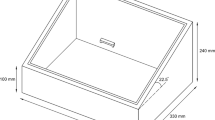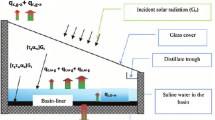Abstract
Freshwater is an essential resource due to climate change, population growth, and groundwater contamination. The seas and oceans contain a lot of valuable saltwater. One of the economic ways to convert this expensive product from salt water is to use a stepped solar still. The low efficiency of the majority of solar stills has intrigued researchers to find ways to improve their performance. In this paper, using a neural network based on experimental data, the optimal conditions to reach maximum water production have been identified. The flow rate of desalinated water, the impact of sunlight radiation, the cover tilt angle regarding the horizon, the sodium metasilicate addition to the glass cover, the distance between the glass cover and the water surface, and finally the flow rate of the cooling stream over the glass cover were examined. The results have shown that to achieve more water at higher solar radiation levels, it is necessary to increase the cover tilt angle. Also, in the same conditions, using a low amount of sodium metasilicate compared to not using it increases efficiency by 34% on average. Also, decreasing the distance between the glass cover and the water surface increases the efficiency of this equipment. It was also observed that in low solar radiation, a low cooling flow rate is needed, and in high solar radiation, a high cooling flow rate is needed for more efficiency.










Similar content being viewed by others
References
Abiodun OI, Jantan A, Omolara AE, Dada KV, Mohamed NA, Arshad H (2018) State-of-the-art in artificial neural network applications: a survey. Heliyon 4:00938. https://doi.org/10.1016/j.heliyon.2018.e00938
Beng Yeo K, Meng Ong C, Te Tze Kin K (2014) Heat Transfer Energy Balance model of single slope solar still. J Appl Sci 14:3344–3348. https://doi.org/10.3923/jas.2014.3344.3348
Dev R, Abdul-Wahab SA, Tiwari GN (2011) Performance study of the inverted absorber solar still with water depth and total dissolved solid. Appl Energy 88:252–264. https://doi.org/10.1016/j.apenergy.2010.08.001
El-Samadony YA, El-Maghlany WM, Kabeel AE (2016) Influence of glass cover inclination angle on radiation heat transfer rate within stepped solar still. Desalination 384:68–77. https://doi.org/10.1016/j.desal.2016.01.031
Elsheikh AH, Katekarb VP, Muskensc OL, Deshmukhd SS, Elazize MA, Dabourf SM (2021) Utilization of LSTM neural network for water production forecasting of a stepped solar still with a corrugated absorber plate. Process Saf Environ Prot 148:273–282. https://doi.org/10.1016/j.psep.2020.09.068
Jathar LD, Ganesan S (2021) Assessing the performance of concave type stepped solar still with nanoparticles and condensing cover cooling arrangement: an experimental approach. Groundw Sustain Dev 12:100539. https://doi.org/10.1016/j.gsd.2020.100539
Kabeel AE, Abdelaziz GB, El-Said EM (2018) Augmenting the productivity of solar still using jute cloth knitted with sand heat energy storage. Desalination 443:122–129. https://doi.org/10.1016/j.desal.2018.05.026
Kabeel AE, Abdelaziz GB, El-Said EM (2019) Experimental investigation of a solar still with composite material heat storage: energy, exergy and economic analysis. J Clean Prod 231:21–34. https://doi.org/10.1016/j.jclepro.2019.05.200
Karthick M, Gnanaraj SJ, Appadurai M, Jeshurun SB (2021) Productivity enhancement of a single slope solar still with energy storage medium. Mater Today Proc. https://doi.org/10.1016/j.matpr.2021.09.548
Ketabchi F, Gorjian S, Sabzehparvar S, Shadram Z, Ghoreishi MS, Rahimzadeh H (2019) Experimental performance evaluation of a modified solar still integrated with a cooling system and external flat-plate reflectors. Sol Energy 187:137–146. https://doi.org/10.1016/j.solener.2019.05.032
Manokar AM, Taamneh Y, Winston DP, Vijayabalan P, Balaji D, Sathyamurthy R, Sundar SP, Mageshbabu D (2020) Effect of water depth and insulation on the productivity of an acrylic pyramid solar still—an experimentalstudy. Groundw Sustain Dev 10:100319. https://doi.org/10.1016/j.gsd.2019.100319
Mashaly AF, Alazba AA, Al-Awaadh AM, Mattar MA (2015) Predictive model for assessing and optimizing solar still performance using artificial neural network under hyper arid environment. Sol Energy 118:41–58. https://doi.org/10.1016/j.solener.2015.05.013
Nazari S, Bahiraei M, Moayedi H, Safarzadeh H (2020) A proper model to predict energy efficiency, exergy efficiency, and water productivity of a solar still via optimized neural network. J Clean Prod 277:123232. https://doi.org/10.1016/j.jclepro.2020.123232
Porrazzo R, Cipollina A, Galluzzo M, Micale G (2013) A neural network-based optimizing control system for a seawater-desalination solar-powered membrane distillation unit. Comput Chem Eng 54:79–96. https://doi.org/10.1016/j.compchemeng.2013.03.015
Sathyamurthy R, Kabeel AE, Balasubramanian M, Devarajan M, Sharshir SW, Manokar AM (2020) Experimental study on enhancing the yield from stepped solar still coated using fumed silica nanoparticle in black paint. Mater Lett 272:127873. https://doi.org/10.1016/j.matlet.2020.127873
Shahdabadi RS, Mortazavi A, Lotfi P, Shakib SE (2021) An experimental study of feedwater flow rate effects on technical and economic performances of a stepped solar still. Braz Soc Mech Sci Eng 43:372. https://doi.org/10.1007/s40430-021-03091-5
Sharshir SW, Elhelow A, Kabeel A, Hassanien AE, Kabeel AE, Elhosseini M (2022) Deep neural network prediction of modified stepped double-slope solar still with a cotton wick and cobalt oxide nanofluid. Environ Sci Pollut Res. https://doi.org/10.1007/s11356-022-21850-2
Yacim JA, Boshoff DG (2018) Impact of artificial neural networks training algorithms on accurate prediction of property values. J Real Estate Res 40:375–418. https://doi.org/10.1080/10835547.2018.12091505
Acknowledgements
The authors express their gratitude to Arak University for furnishing all the necessary materials and resources for the effective execution of this research. We are also grateful to Rahim Zahedi pur, for his involvement in carrying out the experimental testing.
Author information
Authors and Affiliations
Corresponding author
Ethics declarations
Conflict of interest
There is no potential conflict in this investigation and in this regard I have prepared this paper with the awareness and confirmation of all co-authors.
Additional information
Editorial responsibility: S. Mirkia.
Rights and permissions
Springer Nature or its licensor (e.g. a society or other partner) holds exclusive rights to this article under a publishing agreement with the author(s) or other rightsholder(s); author self-archiving of the accepted manuscript version of this article is solely governed by the terms of such publishing agreement and applicable law.
About this article
Cite this article
Khalili, M., Mostafavi, S.A., Karimi, B. et al. Experimental and numerical analysis of the effective parameters on desalinated water flow in a stepped solar still. Int. J. Environ. Sci. Technol. 21, 8131–8140 (2024). https://doi.org/10.1007/s13762-024-05532-9
Received:
Revised:
Accepted:
Published:
Issue Date:
DOI: https://doi.org/10.1007/s13762-024-05532-9




